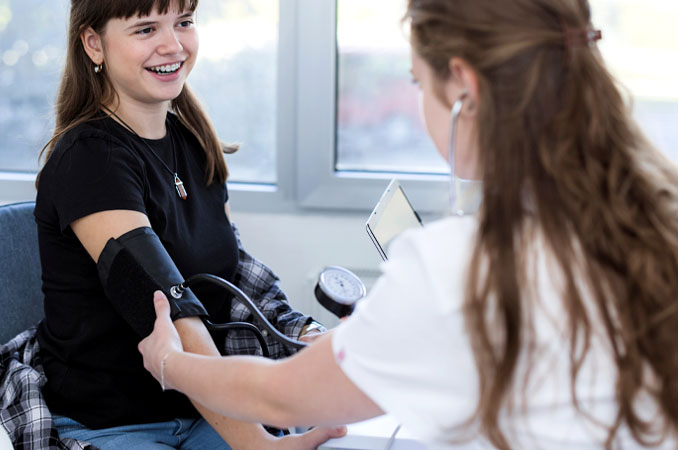
Beat the Mississippi Heat:
Know the symptoms of heat exhaustion
The hottest temperature ever recorded in the state of Mississippi was 115 degrees Fahrenheit in July of 1930. Although it’s been decades since the temperature reached such a high, the month of July continues to be hot for Mississippians every year. We begin to brace for high heat, humidity, and heat indexes well above the century mark.
While the warmth is a welcome break after winter, it can also become dangerous as summer rolls on and temperatures climb even higher. With the many summer activities to keep us busy and active, we must be aware of heat safety, especially when outdoors and the heat’s threat to children.
Outdoor Exercise Risks
Outdoor exercise in high heat and humidity poses certain health risks which should always be taken seriously. Exercise in the heat puts extra stress on your cardiovascular system and increases your core body temperature. To help combat the heat, more blood circulates through the skin, which leaves less blood available for your muscles and increases your heart rate. High humidity creates additional stress because sweat cannot evaporate as readily, causing your body temperature to increase even more. In fair weather and under normal conditions, our body’s cooling system works to adjust to external temperatures. But with extended exposure to heat and humidity, especially during strenuous exercise, we become more likely to develop cramps, heat exhaustion and heatstroke.
If you suspect you’re experiencing symptoms of heat exhaustion, the first step is to move to a cooler area with shade or air conditioning. Lie down to elevate your legs and feet slightly, remove any tight clothes, and sip on water or a sports drink that contains electrolytes.
If someone around you is experiencing heat exhaustion, be sure to take the steps listed previously as well as monitoring the person regularly. Call 911 if the condition worsens.
Heat’s Effect on Children
Studies show that children and infants can’t regulate their body temperature as easily as adults. In fact, children produce sweat at a much slower rate than adults – meaning the heat’s effect on their bodies won’t be as recognizable at first. In addition, the risk for dehydration is greater because a child’s body weight is mostly water. Once the body temperature rises above 104 degrees, the risk of life-threatening heat stroke or organ failure can occur.
In an event that heat exhaustion occurs to your child, its best to bring the child indoors immediately, undress clothes, have the child lie down and raise their feet slightly.
If your child is alert, place into a lukewarm bath or put cool cloths on their skin. If your child is alert and coherent, give sips of cool clear fluids. If vomiting, turn onto their side to prevent choking from occurring.
Symptoms of heat exhaustion in children include: increased thirst, weakness and extreme tiredness, fainting, muscle cramps, nausea and vomiting, irritability, headache, increased sweating, cool/clammy skin, and high body temperature.
Tips for everyone wanting to beat the Mississippi heat:
-
Take it easy. If you normally exercise indoors, keep it moderate when you take things outdoors. As you adapt to the heat, you can increase your intensity slightly and increase the length.
-
Hydrate well. Your internal cooling system depends on adequate hydration – and rehydration during exercise. As a general rule of thumb, you should drink 15-20 fluid ounces of water within 2-3 hours prior to exercise and another 8-10 fl. oz. within 10-15 minutes prior. During exercise, you should have 8-10 fl. oz every 10-15 minutes. If you are exercising longer than 90 minutes, you should drink a sports drink (with no more than 8 percent carbohydrate) every 15-30 minutes.
You can also monitor your fluids by the color of your urine. The clearer it is, the more hydrated you are. Urine dark in color indicates you are dehydrated.
-
Dress light. Loose, lightweight clothing is key during exercise in high heat. This helps sweat evaporate more readily and helps cool your body since it has more access to air. Moisture-wicking material also keeps excess sweat off your body.
-
Avoid mid-day heat. Always try to avoid exercising during the hottest part of the day. Early morning or evening exercise is a better option since it will likely be somewhat cooler. For playing children, we suggest limiting their time in the sun as well as avoiding the highest temperature index of the day.
-
Apply sunscreen. Sunscreen is a must since sunburns are not only painful, but also decrease the body’s ability to cool itself.
-
Stay inside. If your activities permit, take things inside where it’s cooler. A local gym, mall, stairs in an air-conditioned building and even a swimming pool are great places to be active.
If you or someone else seems to be having trouble during outdoor activities, it is important to get out of the heat and seek help. Drink plenty of water and cool off. If symptoms do not improve within 60 minutes, or if a fever of 102 degrees is present, seek immediate medical attention. Here are signs and symptoms of heat-related illnesses:
-
Cool, moist skin with goose bumps when in the heat
-
Heavy sweating
-
Headache
-
Dizziness or faintness
-
Fatigue
-
Muscle cramps
-
Nausea or vomiting
-
Rapid heartbeat
-
High body temperature (104 degrees or higher)
-
Lack of sweating (skin feels hot and dry)
-
Flushed skin
-
Rapid breathing
-
Rapid heartbeat
-
Weakness
-
Headache
-
Dizziness or hallucinations
-
Muscle cramps
We encourage everyone to be active – but play it safe and don’t risk your health. We can beat the heat!




 Women's Health
Women's Health Eat Healthy
Eat Healthy Exercise
Exercise Health & Wellness Articles
Health & Wellness Articles